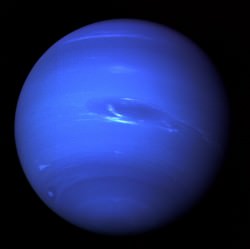New images from NASA’s Chandra X-Ray Observatory show the environment around the supermassive black hole at the heart of M87, a nearby giant elliptical galaxy. Chandra detected loops and rings in the hot gas that surrounds the galaxy. These loops are evidence of periodic eruptions near the supermassive black hole, which send shockwaves through the surrounding gas. These outbursts happen every few million years, and prevent the gas in the cluster from cooling to create stars.
Continue reading “Black Hole Stops Star Formation in Elliptical Galaxy”
Astronomers Peer Inside a Quasar
Quasars are some of the brightest objects in the Universe, and astronomers believe they’re caused by the outpouring of radiation from the environment around an actively feeding supermassive black hole. New research using the Chandra X-Ray Observatory has looked inside a quasar, to see the disk of material spiraling into the black hole. Astronomers used the gravity from a relatively nearby galaxy as a gravitational lens to focus the light from the more distant quasar, giving this impressive view.
Continue reading “Astronomers Peer Inside a Quasar”
Spacecraft Sees Mars Rover from Orbit
The first test images from NASA’s Mars Reconnaissance Orbiter have been difficult to appreciate, since they don’t show any familiar landmarks or give a sense of scale. But today the spacecraft delivered the goods, with a photograph from orbit of NASA’s Opportunity Mars rover, perched at the edge of Victoria Crater. It’s possible to make out the shape of the silver rover, and see its tracks in the Martian soil. By using both the aerial and ground level views, planetary scientists will be able to plot out the rover’s next moves in search of evidence of past water.
Continue reading “Spacecraft Sees Mars Rover from Orbit”
Folds on the Surface of Enceladus
This Cassini photograph shows the southern polar region of Saturn’s moon Enceladus. This is the region of the moon that is known to be geologically active, spraying water ice into orbit around Saturn. It has deep folds and ridges, clearly visible at the top of the image. Cassini took this image on September 9, 2006 when it was approximately 66,000 kilometers (41,000 miles) from Enceladus.
Continue reading “Folds on the Surface of Enceladus”
Planets Can’t Form in Rough Neighbourhoods
It takes a nice safe environment for planets to form, according to new data gathered by the Spitzer Space Telescope. The powerful infrared observatory recently observed powerful O-type stars in the process of stripping away nearby planet-forming disks. The gigantic stars can have as much as 100 times the mass of the Sun, and generate killer solar winds. In one case, the planetary disc takes on a comet-like appearance, as planetary material is blown away from the star.
Continue reading “Planets Can’t Form in Rough Neighbourhoods”
Hubble Finds Distant Extrasolar Planets
The Hubble Space Telescope has identified 16 stars that could have extrasolar planets. The discoveries were made as part of a new Hubble survey, called the Sagittarius Window Eclipsing Extrasolar Planet Search (SWEEPS). This survey looked at 180,000 stars in the central bulge of the Milky Way – 26,000 light years away. The discovery was made using the transit method, where planets dim their parent stars slightly as they pass in front. Further observations will be needed to actually calculate the mass of the transiting planets.
Continue reading “Hubble Finds Distant Extrasolar Planets”
Nearby Universe Mapped in 3 Dimensions
A new map developed by an international team of astronomers should help you find your way around the Universe – at least to a distance of 600 million light years. This new 3-dimensional map plots out the locations of all the major superclusters of galaxies and the voids that surround them. It was developed using data from the 2MASS Redshift Survey, which calculated the redshifts (and therefore the distances) of 25,000 galaxies across the entire sky.
Continue reading “Nearby Universe Mapped in 3 Dimensions”
Are There Oceans on Neptune?

Continue reading “Are There Oceans on Neptune?”
Podcast: The Search for Dark Matter
Dark matter . . . What is it? Nobody knows for sure, but it’s definitely there. Or maybe it’s not there, and we just need some redefinition of gravity at vast scales. Join Fraser and Pamela as we discuss the discovery, detection, and possible explanations of dark matter.
Continue reading “Podcast: The Search for Dark Matter”
What’s Up this Week: October 2 – October 8, 2006
“Shine on… Shine on Harvest Moon… Up in the sky. I ain’t had no clear skies since January, February, June and July…” Oh! Greetings, fellow SkyWatchers! Welcome to this week’s edition where we’ll be taking a closer look a lunar features and just what makes a globular… Well… A globular! Time to get out the binoculars and telescopes and turn a eye to the sky, because…
Here’s what’s up!
Continue reading “What’s Up this Week: October 2 – October 8, 2006”
